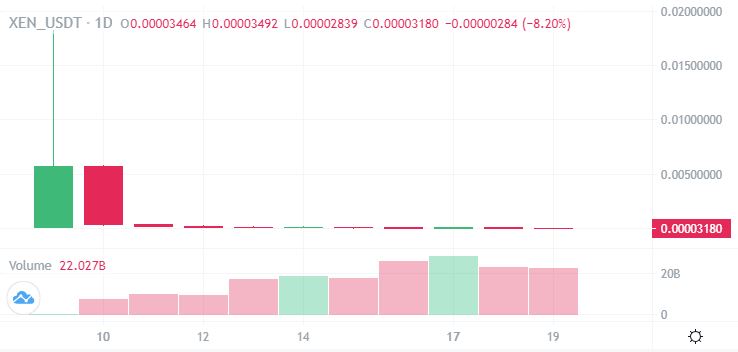On December 20th, MEXC launched a Twitter space live broadcast on MEXC Twitter. The theme of this event is “With the rise of The Beacon, will L2 lead GameFi?”. And we were so honored to have so many professionals: Carol, BD from Arbitrum; Dieg, the CEO of The Beacon; Karel, the Co-Founder & COO of Treasure; Rich Cabrera, the Founder of Ready Player DAO; Roy, the GGSlayer Ambassador; and Furanku, CTO of The Beacon also came to join our conversation as a mystery guest.

Antonio:
Hi, everyone! Thank you so much for joining our Twitter Space today. As you see, our topic today is “With the rise of The Beacon, will L2 lead GameFi?”, I believe everyone here knows “The Beacon”, or you are playing or have played The Beacon.
And it’s really our honor to have so many professionals: Carol, BD from Arbitrum; Diego from The Beacon, and Karel, the Co-Founder & COO of Treasure, and Rich, the Founder of Ready Player DAO; and Roy, the GGSlayer Ambassador here to join our conversation. Welcome all of our guests. Thank you for spending your time joining our conversation. I believe we are going to have a wonderful time together.
Today, we also have a $500 airdrop for today’s event. You can participate via the event link. First of all, let’s welcome all of our guests to have a short introduction of themselves.
Guests introduction
- Carol: Hi guys, I’m Carol, BD of Arbitrum Space – a notable media seeking to support Arbitrum projects.
- Diego: Hey guys I’m Diego Vidaurre, Co-founder & CEO of The Beacon. A fantasy roguelike RPG that blends in the social aspect of MMOs together with web3
- Furanku: Hello, everyong! My name is Rafael, I am the CTO of The Beacon. Mostly in charge of technical stuff. I am also super involved in game design as part of The Game development aspect as well! Happy to be here and I am from Chile.
- Karel Vuong: Hey everyone, I’m Karel Vuong, the Co-Founder & COO of Treasure. We’re building the ‘decentralized Nintendo’ – a bottom-up ecosystem of games built around our token MAGIC to transform game publishing. We are a vibrant and intimate community of game builders, creators, and players united around a common purpose – to connect through shared experiences and fun!
- Rich Cabrera: Hi, Rich Cabrera, Founder of Ready Player DAO, A web3 gaming DAO focusing on elevating the web3 gaming space through community, content marketing, and investments. We support content creators and games through content!
- Roy: Hey guys, I’m Roy. Ambassador of GGslayer, a community-driven web3 gaming platform aiming to explore and provide corresponding help for GameFi projects that are at the early stage.
Question Part
Q1: We’d love to know what The Beacon is, what game modes it has, and whether it intersects with the development team of TreasureDAO?
Answer:
- Diego: The Beacon is a roguelike RPG dungeon crawler that blends in the social aspect of MMOs together with NFTs. The game spins around 2 core concepts: A sólo roguelike dungeon crawler in which players go through procedurally generated dungeons where they must go as far as they can in order to obtain loot, and B) a highly social gameplay powered by an in-game housing system and an in-game open world-like town for players to interact with. Competition and co-op are also part of the the game’s scope in the future
- Karel Vuong: The Beacon is one of many games that are ‘Powered by Treasure’. These games and teams aren’t formally part of Treasure at the core, but we work very closely together in many different ways as partners – all with the goal of building fun games and amazing experiences for our players. This is tied to our decentralized Nintendo thesis as we have 10+ other game partners that we work together with who are building with and on top of Treasure and our token MAGIC in some way, shape or form.
- Franku: There is one thing to bring up is the social part to keep players doing more interaction.
Q2: TheBeacon has been online for only 2 weeks and already has over 24,000 players in the game. Can you share how the game has managed to attract so many users in a short period of time?
Answer:
- Carol: The interface is friendly and the UX is grateful as well. Many users now have to pay a large amount of fees, charging for items in the game and Free-to-play will play an important role in leading the gaming sector in the short term ahead. The Beacon has just launched the settlement so far. Free to play still an early definition and on an early development as well. But the data never lies. Only 2 weeks with 24,000 players. We can’t deny a great time waiting for GameFi. Congrats The Beacon.
- Diego: I think the reason why the game was successful at drawing so many people resides in the fact that it is basically fun to play. When we began developing the game we set out to build a fun game first that included the benefits of blockchain, but that didn’t necessarily require them. This means that we set out on building a fun-first product, rather than a game that adapts to grant utility on the blockchain level. The game also, to my estimation, appeals to a rather familiar graphic style that resonates with most people (especially let’s say those around my age) where we grew up playing games that look like this one. Competition, sociability, good art, fun yet challenging gameplay and the capacity and allowing people to show off their stuff were some of the concepts that I believe made the prototype quickly successful.
- Karel Vuong: First and foremost, it’s fun. It launched with a game that people could play that was easy and free to pick up but difficult to master. In its early playable prototype, it’s one of few games enhanced by web3 that satisfied the fun factor and offered a great look into the starting point of a game. Knowing it’s probably only 5% of what we should eventually come to expect is amazing.
- Rich Cabrera: It’s easy to understand. The objective of the game is to beat a dungeon and receive items you actually own as a reward. Games that are easy to onboard and express the benefits of web3 gaming in the way the Beacon is doing so will have larger adoption over the complex.
Q3: Has The Beacon issued its own game token, what is the mechanism and how is it related to MAGIC?Answer:
- Diego: As for now, the game doesn’t really have a token on its own. We plan to have one, but we belive that in order to do so, the game must become more feature-rich in order to create comprehensive and sustainable economic loops that allow a token to exist without , well, collapsing. Fundamentally, MAGIC serves as the game’s unit of account. Instead of creating our own token, we relied on Treasure’s economic infrastructure to power the game. As for now MAGIC is used on the secondary market, but we intend to include TIP-09 Emissions and are evaluating mechanisms of the token in the future.
Q4: How does The Beacon play to make money? How can users get the game token airdrop?
Answer:
- Diego: The game focuses on a fun-first approach. People can make money playing the game, but that’s a secondary feature rather than the game’s motive of existence. The way we go about users getting tokens is through TIP-09 emissions, through BCN emissions that will be disclosed in the future as game loops are established, and of course through rare and limited NFTs that people obtain through the gameplay during specific periods of time.
- Karel Vuong: Beyond The Beacon’s eventual planned token $BCN, MAGIC is used across the entire Treasure ecosystem in all of its games. It’s the reserve asset and unit of account in our marketplace Trove, our AMM MagicSwap, and can be rewarded by games powered by Treasure based on gameplay, skill and strategy.
Q5: I believe all the guests have been playing this chain game and are veteran players, so what do you think about this game as The Beacon players and what are the design or mechanism highlights that attract you?
Answer:
- Carol: I think I feel comfortable and interesting when playing this game. Creating a space where people desire to spend time in and offer them something useful if they want to spend money on improving their experience is a great idea of The Beacon. That’s the feature that I find most attractive. In addition, some of the highlights of the game that make me feel attractive can be mentioned as: Funding, Genesis Collection & Low entry for new players who want to enjoy the game.
- Karel Vuong: It has everything you would want in a roguelite game. Fast and dynamic gameplay that anyone can play but not everyone can master. Something that can be played if you only have 5 minutes in your day. It also has different game elements that can appeal to different players. If you like interior design, you can decorate your house. If you like doing the dungeon runs, you can go at your own pace, speed run it, or try to kill everything. For me, I like the last point and posted daily videos of clearing the dungeons while not taking damage.
- Rich Cabrera: I think it feels very early and we are in the stage of building a community and doing these fun, yet challenging, dungeon runs. The grand idea behind the beacon is to build something larger and more akin to an MMO, being early and being able to grab loot and a founding character is exciting but it’s the team’s vision and exceptional delivery of what they have so far that’s capturing attention & retention
- Roy: I think the overall design is pretty simple and clean, the game mechanics are also easy to follow, but this does not mean that the game is not good enough. Instead, the prototype of the game and the mode of operation has come out, the follow-up of other maps or PVE mode design can be directly embedded in. Waiting for a new dungeon every day and the future map design is the point that attracts me the most. l
Q6: When it comes to The Beacon, we have to mention Treasure DAO. I would like to ask Karel Vuong, Co-Founder of Treasure DAO, to introduce Treasure DAO and the team behind it?
Answer:
- Karel Vuong: Treasure is building the ‘decentralized Nintendo’ – a bottom-up ecosystem of games built around our token MAGIC to transform game publishing. There are 3 parts to Treasure: (1) fun, composable games powered by Treasure using composable resources like MAGIC; (2) community of players and builders; and (3) infrastructure.
Q7: How does Treasure DAO see the positioning of The Beacon in the ecosystem?
Answer:
- Karel Vuong: The Beacon is one of the top games that have emerged within the Treasure ecosystem, certainly since launching just over a year ago now. As an action roguelite RPG, it sits within a popular, adored genre that appeals to a very large player base and are excited to see them continue to develop their game and grow their player community. After seeing its success, we’ve seen our conversations with new games accelerate and look forward to bringing on the next Beacon to launch on Treasure (more news to come)!
Q8: Why did Treasure DAO choose to migrate from the Ethereum mainnet to build on Arbitrum?
Answer:
- Karel Vuong: It’s just not viable for games to run on ETH mainnet given the transaction costs and speed so you need to look at an L2. As for why Arbitrum in particular, we’re ETH maxis and felt the security was very important. We also wanted to make a name for ourselves. When it moved over, DeFi was king of Arbitrum and the NFT and gaming ecosystem was nonexistent. This allowed us to build this all from scratch and to be able to work closely and directly with the Arbitrum team to help collectively shape the agenda and grow the ecosystem together.
- Rich Cabrera: ethereum mainnet is not viable for most games, an L2 or low cost chain is more conducive for processing gaming events/tx
Q9: What changes do people think Arbitrum can bring to the chainstream?
Answer:
- Carol: Arbitrum’s features that users wanna come and build. From the heat of Aptos to Arbitrum, and Arbitrum TVL that shows on many data sources, we can see Arbitrum can provide a large source for the crypto as well.
Q10: With Binance going list MAGIC, is there any possibility for a wave of heat for Chain Tour?
Answer:
- Carol: Currently, we are in a bear market experiencing many important events that affect the market a lot. However, Arbitrum ecosystem grew TVL a lot even in this gloomy market and 2 projects, GMX and MAGIC were listed on Binance. This is a first sign for next year’s Arbitrum wave as the market recovers and for Treasure Dao projects like Beacon
- Karel Vuong: We sure hope so! We had 6 exchanges go live this month, including Binance and Coinbase which has been great to get MAGIC in the hands of the retail market. Our hope though is that this serves as a good entry point for new players to come into Treasure, pick up a game (like The Beacon), and start playing and discovering everything we have to offer here. Between our current set of games, all of the new games set to launch and announce soon, and other plans we have at Treasure, we think the future is bright.
Q11: Last question, from Axie to STEPN, the Chain game has gone through several stages, and the end game of the project seems to be inevitably in a death spiral. So how do you guys see Chain games relying too much on the paragon design, and will The Beacon be the new direction of Chain game development?
Answer:
- Carol: The problem of play to earn is that the majority of projects focus too much on earnings and neglect the game itself. Projects like Axie and other similar page-based games have overemphasized the financial attribute of “Fi”, so that the product itself can only be considered a financial product rather than a “game”. We need to focus more on the game itself and make the game healthy and sustainable. I think there will be more NFT-based gamefi projects followed after “the beacon” in the future. I believe in attractive gameplay and a sustainable economy in the game. NFT-based gamefi projects like Beacon will lead the trend of play to earn in the future.
- Diego: I believe that P2E is inevitably transitioning to a more sustainable model. To some degree, at least so far, our game has relatively proven that there is interest from the broad public for web3 games as long as they are fun and engaging. Our game doesn’t really have a token, yet it generated tons of traction and market activity. The way we see it is as NFTs or Digital collectibles + the benefits of blockchain and the multiplicity of ways that it can be used towards the extrapolation of game assets / game efforts towards an open network what will drive the use case for web3 games rather than P2E per se. * Elaborate on sustainability, skill, player driven demand, etc.
- Rich Cabrera: P2E is going to go away as we knew it. What Beacon is showing is proof of skill and the ability to earn and trade these items, it’s an entirely different concept that plays more into the rarity of the items, when you got them, how you get them, etc..
- Roy:The current dilemma of P2E is that most projects put too much emphasis on Earn and forget that the game itself. Projects like Axie and other similar page-based games have overemphasized the financial attribute of “Fi”, so that the product itself can only be considered a financial product rather than a “game”. We need to focus more on the game itself and make the game healthy and sustainable. I think there will be more NFT-based gamefi projects followed after “the beacon” in the future.
Join MEXC and Get up to $10,000 Bonus!
Sign Up


